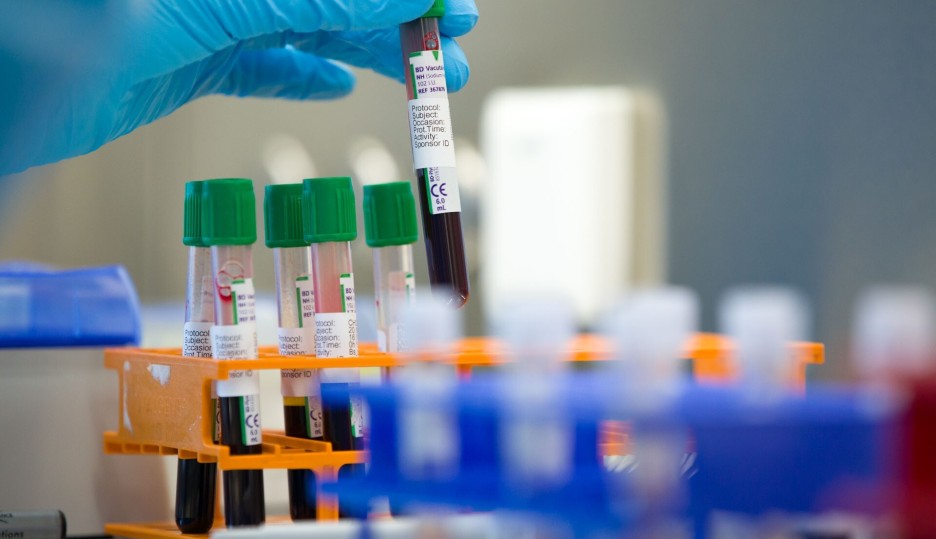CHDR’s cellular laboratory is a state-of-the-art, fully-equipped facility designed for comprehensive cell culture work. It includes advanced equipment such as flow cytometers, multiple flow hoods and incubators, a fluorescence microscope, a stereo microscope, and ELISA and ELISPOT readers. In addition to bedside laboratory testing and a magnetic cell sorter, the laboratory is well-equipped for studying drug effects at the molecular and cellular levels.
Lab capabilities
-
ELISpot is a highly sensitive assay used to measure immune responses at the cellular level, specifically the release of cytokines. In this method, cells are stimulated in wells containing cytokine-specific antibodies, which capture the released cytokine in close proximity to the cell. Spots appear after binding of the cytokine and subsequent staining with secondary antibodies, providing a visual representation of cytokine production.
-
We offer two methods for isolating peripheral blood mononuclear cells (PBMCs) to suit different research needs. PBMCs are isolated using a density gradient, which allows the separation of mononuclear cells from granulocytes and red blood cells following centrifugation. The first method uses SepMate tubes with Lymphoprep for large-scale PBMC isolation, ideal when a high volume of cells is required. The second method uses Cell Preparation Tube (CPT) tubes, providing a reliable option for smaller-scale isolations, often used for protein and gene expression studies.
-
At CHDR, we use the RoboSep-S system for magnetic cell sorting, a fully automated method for isolating specific cell types from peripheral blood mononuclear cells (PBMCs) or whole blood. The system allows for both positive and negative selection: in positive selection, the target cells are labeled with magnetic beads, while in negative selection, unwanted cells are labeled. This automated process eliminates the need for manual intervention, ensuring a streamlined and efficient cell isolation procedure for research applications.
-
CHDR has a fully equipped cell culture laboratory, with flow hoods, CO2 incubators, a flow cytometer, a magnetic cell sorter and a fluorescent microscope, run by a team of experienced bioanalytical staff. This offers the possibility to set up and apply cell-based systems for qualitative and quantitative characterisation of innate and adaptive immune responses, and the effect of (pharmacological) interventions.
-
At CHDR, we have developed a comprehensive set of ex vivo challenges to assess the effects of compounds on various targets and biological pathways. These challenges enable us to activate the innate immune system in either whole blood or PBMC samples. Our available innate immune stimuli include LPS (alone or in combination with ATP, cholesterol crystals, or aluminium hydroxide), chemotactic peptide (fMLP), coagulation factors, zymosan, Pam3SK4, double-stranded RNA (poly I:C), flagellin, single-stranded RNA, and CpG DNA. These tools allow us to closely examine immune responses and the effects of pharmacological compounds on immune function.
-
We offer a comprehensive set of ex vivo challenges to assess the effects of compounds on T cell responses and associated biological pathways. These challenges enable us to activate T cells in either whole blood or PBMC samples. Our available T cell stimuli include superantigen (SEB), PMA/ionomycin, PHA, and neoantigens such as tetanus toxoid and keyhole limpet hemocyanin (KLH). These tools allow us to closely examine T cell activation and the effects of pharmacological compounds on T cell function and immune responses.
-
At CHDR, we offer PhosFlow to help clients investigate cellular signalling and phosphorylation events in response to various stimuli or compounds. Our PhosFlow assays enable precise measurement of protein phosphorylation in individual cells, providing valuable insights into signalling pathways, immune cell activation, and therapeutic effects, all through advanced flow cytometry analysis.
-
At CHDR, we provide immunophenotyping services using flow cytometry to analyse and characterise cell populations based on specific surface and intracellular markers. Our advanced flow cytometry platforms allow for detailed profiling of immune cells, enabling the assessment of immune responses, cell differentiation, activation, and disease-related alterations. This service is valuable for investigating the effects of compounds on immune function and understanding the cellular composition of various biological samples.
-
Ex vivo immunometabolic profiling focuses on understanding the metabolism of immune cells and how metabolic changes influence their function. By analysing immune cells in isolated samples, we investigate how different metabolic pathways—such as glycolysis, oxidative phosphorylation, and fatty acid oxidation—regulate immune responses. Our advanced profiling techniques enable the assessment of metabolic shifts during immune cell activation, differentiation, and effector functions.
-
Ex vivo mitochondrial function analysis provides a comprehensive approach to studying the role of mitochondria in cellular health and function. By assessing mitochondrial bioenergetics, including parameters such as oxygen consumption, ATP production, and membrane potential, we can gain valuable insights into how mitochondrial activity influences immune cell metabolism and overall cellular responses. This analysis is essential for evaluating the effects of compounds on mitochondrial function, which plays a key role in processes like immune cell activation, differentiation, and apoptosis.
-
Our in-house biomarker lab offers specialised services for ex vivo lysosomal function analysis, a crucial tool in assessing cellular health and the efficacy of therapeutic interventions. We employ state-of-the-art techniques to analyse lysosomal activity in patient-derived samples, providing valuable insights into cellular processes related to lysosomal storage disorders, drug development, and ageing.
-
Together with our partner labs, we can perform immunohistochemistry to help viualise and localize specific proteins within tissue samples, providing valuable insights into the molecular landscape of diseases and therapeutic effects. Our expert team uses cutting-edge techniques to detect protein expression, distribution, and cellular localisation, helping to characterise biomarkers, assess tissue pathology, and evaluate the effects of novel treatments.
-
Together with our expert partners, we offer a range of omics services, including lipidomics, metabolomics, proteomics (Olink), and transcriptomics, to provide comprehensive insights into biological processes and therapeutic effects.
Transcriptomics: Through RNA sequencing, we provide in-depth gene expression profiling, identifying molecular targets and therapeutic impacts.
Lipidomics: We profile lipid species to understand membrane composition, signalling, and metabolic disorders.
Proteomics (Olink): Using the Olink platform, we analyse hundreds of proteins with high sensitivity, ideal for biomarker discovery and disease research.
Metabolomics: Advanced mass spectrometry and chromatography techniques allow for detailed analysis of metabolites, aiding in the study of metabolism and drug responses.
We offer in-house bioinformatics services to analyse omics datasets.


